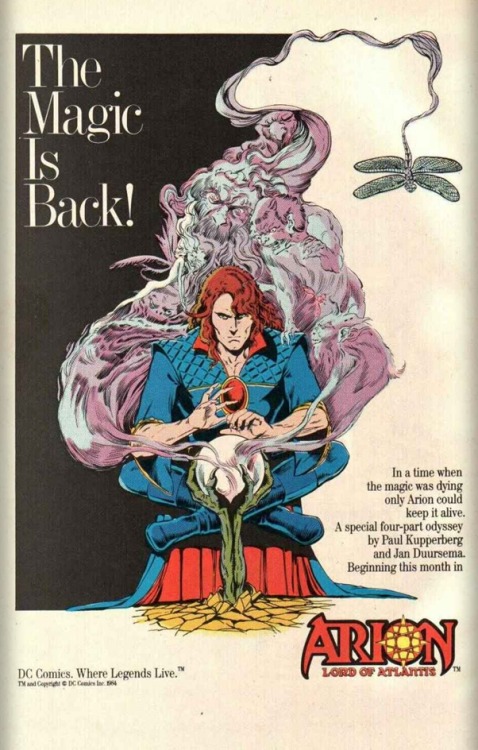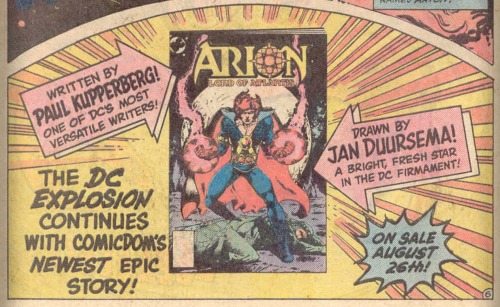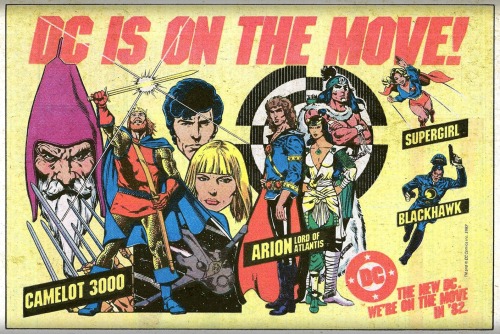Arion, Lord Of AtlantisArion, Lord of Atlantis started as a back-up feature in the Warlord (issue #5
Arion, Lord Of AtlantisArion, Lord of Atlantis started as a back-up feature in the Warlord (issue #55 to be exact) back in 1982. Apparently, then-editor Laurie Sutton mentioned to Paul Kupperberg in passing that Dragonsword (the Warlord’s current back-up feature) wasn’t going to last forever and they were going to need a new back-up feature to run. The only requirement for something to be a back-up feature in the Warlord was that it had to be of the sword and sorcery/fantasy genre. Kupperberg suggested a story about a young mage and Sutton requested that it be set in Atlantis - and that, my friends, is the origin of Arion, Lord of Atlantis. The hardest part of the whole creation process was coming up with a name for Arion (which was finally decided at the last possible minute) - other potential names included Orion, Atlan and Tynan. Arion was ultimately created by Kupperberg (writer) and Jan Duursema (artist).The Arion, Lord of Atlantis back-up feature ran from Warlord #55 to #62 (1982). The back-up feature was alright and focused heavily on myth and magic and cosmic blah blah blah, but I found the language was very ‘Old English’ (i.e.: 'nay’, 'ye’, 'verily’,…) and that took away from my enjoyment of the series*. Nevertheless, it still set up the premise of a plot and some interesting story elements/characterization and it was enough to please fans. By the time the back-up feature ended, Arion had his own ongoing series the following month - which is relatively unheard of for a back-up feature. Although we shouldn’t dismiss the power of a back-up feature… Legion of Super-Heroes started as a back-up feature and look how they turned out. Conquerors of the Barren Earth then replaced Arion as the Warlord’s back-up feature once Arion got his own ongoing series.In the early 70s, the sword-and-sorcery genre was experiencing a revival. The most notable example of this was Marvel Comics’ Conan the Barbarian published in 1970. In an attempt to cash in on this trend, DC comics rolled out a few sword and sorcery titles during the 70s: Sword of Sorcery, Tor, Claw the Unconquered, Kong the Untamed, Stalker, Beowulf and the Warlord. Of all the DC sword and sorcery titles released, only the Warlord managed to survive into the 80s. In 1982, the Conan the Barbarian film was released and it gave the sword and sorcery genre another surge of popularity. Keeping this in mind, in the early 80s, DC comics was publishing at least seven sword and sorcery titles: the Warlord, Arak, Amethyst, Masters of the Universe, Camelot 3000, Conquerors of the Barren Earth, and Arion, Lord of Atlantis. Arion, Lord of Atlantis #1 picks up where the back-up feature from the Warlord dropped off, and the reader is thrown into the middle of a story. Kupperberg was continuing his previously established storyline and Jan Duursema resumed pencilling chores on the ongoing series. Fans were already accustomed to Duursema’s pencils, as she had previously pencilled a few issues of the Warlord. I’d probably argue that Duursema’s pencilling got better as the series progressed, but that just may be me getting used to the art as it seemed to be a nice fit for the atmosphere and mood of the story.It needs to be noted that while the series was named after Arion, his three comrades-in-arms (the oriental Lady Chian, the Native American Wyynde and the teenaged Mara) were just as popular as Arion was. I’d probably argue that Lady Chian was MORE popular with the fans than Arion - eventually Lady Chian received her own back-up feature in the series. Kupperberg is known for writing strong, self-sufficient women (ex: Supergirl and Powergirl) and Lady Chian was no exception. It was later revealed the Lady Chian was loosely based on Mariko from the Shogun series, and I’m going the guess that Wyynde was inspired by Chief Bromden from 1975’s One Flew Over The Cuckoo’s Nest. Mara was named after Kupperberg’s wife and was mainly inserted as a comic relief character to contrast the other three stoic serious characters.One of the strong points of this series is that Kupperberg inserts a lot of characterization into the storyline which results to a lot of characters/interpersonal relationships growing and constantly changing. Kupperberg intentionally set it up so that Arion was introduced as a snobbish, anxious, unlikable person with cosmic-like powers just so that Kupperberg had something to work with (ex: allow him to grow as a person and become more human and compassionate). One of the hurdles Kupperberg had to cross was that Arion began the series as an all-powerful mage, and the problem with all-powerful characters is that it’s pretty easy for them to battle any foe and solve any problem. If a character is never really in danger, then the element of excitement is never there. Kupperberg solves this by having Arion lose his magical powers sporadically throughout the series and Arion trying to regain his lost powers is a recurring theme of the book. Another recurring theme is Arion’s conflict with his evil brother (which fans got tired of halfway throughout the series). The series also deals with magic vs science, as science was slowly being introduced to Atlantis and this caused friction amongst the population.The Arion, Lord of Atlantis series is notable for the creators (Kupperberg and Duursema) following through the series from beginning to end. There were a few exceptions of course: Kupperberg left for other projects and Doug Monech took over writing chores from issues #4 to #11, and Cara Sherman Tereno filled in for Duursema from issues #24 to #29. For anyone who didn’t know: Jan Duursema is married to artist Tom Mandrake (and I believe he was inking over her pencils for the first ~12 issues). Editors changed several times throughout the life of the series - it went from Ernie Colon (#1 to #8) to Joe Kubert and finally ended with Karen Berger (#27 - finale).This series lasted 38 issues and a double-sized finale - not bad for what began as a back-up feature. In 1983, advanced sales of Arion led every other DC comic book with a November cover date - which gives you some indication that it was a popular title during the first year of it’s run. Arion’s sales began to decline as interest in the sword and sorcery genre began to decline - so I’m guessing somewhere around summer of 1984. Around this time, the series began to heavily borrow elements from science fiction… I’m just going to say it: at this point in this series his primary weapon is a flame sword (which acts very similar to a light saber) and in issue #22 he battles something that looks like the Sarlacc pit - these are two big nods to 1983’s Return of the Jedi (intentional or unintentional?). I’m not sure if Kupperberg was aware that the series was being cancelled as new supporting characters and storylines were being introduced right until the bitter end. In 1992, Kupperberg tried to revive a modern-day version of the series (Arion the Immortal), but it only lasted 6 issues. Kupperberg finally concluded the Arion story he set out to tell in his Two Tales of Atlantis e-book. While Arion, Lord of Atlantis may have been cancelled in 1985, that did not prevent the series from having some sort of impact on the DCU. The Atlantis in pre-Crisis Arion universe was not the same Atlantis as seen in pre-Crisis Warlord universe (even though one title debuted in the other). I’m not even sure if it was the same Atlantis that Aquaman inhabited. The Crisis On Infinite Earths (in an effort to add cohesion to the DCU) retconned that. It was revealed that Arion’s Atlantis was the same as Aquaman’s Atlantis (as explained in the 1986 Aquaman mini-series), and that Arion was actually Power Girl’s grandfather and that Power Girl was not a Kryptonian (as previously believed) and was actually an Atlantean. Kupperberg was writing Power Girl at the time, so it all worked out (also: Kupperberg tends to run a tight ship in regards to characters he writes). The Dark World that appeared in Arion also played heavily into Amethyst’s Gemworld mythos (edited by Karen Berger) and I think there’s some sort of connection whereas the inhabitants of Atlantis came from Gemworld or something. There’s a 1990 mini-series called Chronicles of Atlantis that deals with all of this. Arion Lord of Atlantis was an enjoyable series with solid writing. The characters are well-written and they grow on you. The locale is set in 45,000 BC, so don’t expect any interaction with any other modern-day DC characters (exception: DC Comics Presents #75 where Arion teams up with Superman - written by Kupperbeg). It wasn’t a ground-breaking series, but it definitely filled the void for a sword and sorcery title and had it’s moment in the sun. Kupperberg did fun things like hold a reader-based costume submission contest in which Arion would wear one lucky reader’s costume for several issues. Kupperberg and Duursema were really cool about interacting with the readers.*When Mara is introduced in Arion, Lord of Atlantis #1 she was a jive-talker using 80s slang (ex: “buster”, “old man”, etc.). Apparently Mara was cast as a street-tough Atlantean kid, and was written to speak like she was from Brooklyn. It was a mistake made before Ernie Colon started editing. Doug Monech phased it out. -- source link
#arion#lady chian#wyynde#kupperberg#atlantis#berger#kubert#moench#duursema#colon#tereno





